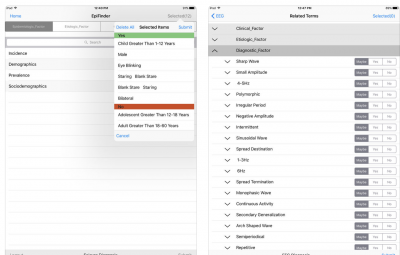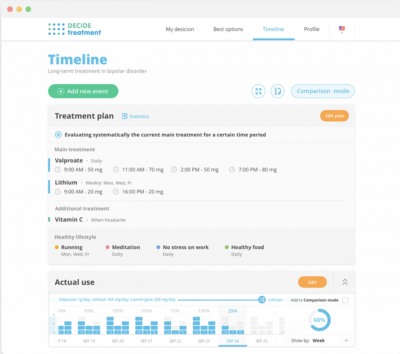The healthcare industry is going through a period of significant digital transformation. Today, healthcare providers are increasingly leveraging technologies like the Internet of Things and mobile apps to enhance efficiency and patient care.
There are different types of mobile health (mHealth) apps that strive to fulfill specific needs. For example, some apps concentrate on the scheduling of appointments, others focus on drug adherence, patient history, and remote video consultations.
mHealth apps have had a significant impact on the overall wellness of patients. For example, the use of mobile applications has reduced hospital readmissions. As mHealth apps can help patients better manage chronic conditions, it can also be leveraged to reduce ER visits and related patient costs.
As a result, we can conclude that mobile apps make dealing with the healthcare system a seamless experience. This means that the presence of mobile apps will continue to grow across the healthcare industry.
In fact, according to Research and Markets, the mHealth app market is expected to be worth approximately $102.35 billion by 2023 (growing at a compound annual growth rate of 29.3% from 2018 to 2023).
If you’re a healthcare institution and you’re thinking about building your own mobile app, how should you start this process?
At present Google Play store has about 2.1 million mobile apps available for download. Apple’s App Store has approximately 2 million mobile apps.
However, 21% of users abandon the apps after using it once. The average mobile retention rate is only 20% after 90 days across industries. Further, as much as 71% of all app users churn within the same period.
This means that you can’t just develop a mobile app and expect it to make the desired impact on patient populations. Instead, you have to first conduct some research and consider many variables that can influence app usage.
Identify a Problem to Solve
It’s imperative for your mHealth app to serve a purpose. It should solve a problem or several problems related to organizational operations or patient care.
For example, you can build an app to make scheduling clinical appointments more efficient. You can even take it a step further and engage in data and analytics to cut down the time spent in waiting rooms.
There’s no reason to reinvent the wheel here, you just have to build a practical and quality app that can enhance patient experiences. If your app isn’t solving a problem or making something better, you’re doing something wrong.
Patient-centric healthcare apps can be used to achieve the following and more:
- Access medical records (including patient history and lab results)
- Drug prescription management
- Enable access to practicing physician databases
- Make an appointment
- Make payments
- Provide maps with detailed directions
- Provide notifications like reminders
- Provide wait time estimates
- Track health metrics
For example, the Mayo Clinic’s Department of Neurology recently developed a mobile app called EpiFinder to enable the correct identification of epilepsy based on the data provided by the patient or care provider.

- Mayo Clinic’s EpiFinder App
During the testing phase, the app was able to identify epilepsy or offer an alternative diagnosis almost 87% of the time. This is an excellent example of a mobile app that’s built to fulfill a purpose.
Choose the Right Platform for Your mHealth App
Before you hand over the mobile development project to your in-house team or outsource it to a third-party developer, you have to first decide on the platform. Is your app going to run on an Android, iOS, or hybrid platform?
Your decision will have an impact on the user interface, the adaptability of the app, and how much work your developers have to put into it. The appearance and general aesthetics will also work differently on different platforms.
However, when catering to diverse patient populations, the best approach would be to accommodate both Android and iOS or take a hybrid approach.
Regardless of the platform, you choose to go with, it’s imperative to make it highly user-friendly by keeping it simple. This will ensure that patients and medical professionals use it as intended and keep coming back.
Make a Prototype and Test
When your team starts building a mobile app, your aim should be to first prototype and test. This will help you identify the gaps between what you want to achieve and what you can’t. It’ll also help you ascertain how much investment will be required to reach your target.
For example, Innlandet Hospital Trust outsourced the development of a mHealth app to us at Intersog with the goal of helping both patients and doctors (make better use of available information and) make better treatment decisions.
Over a period of two months, we developed a fully interactive prototype and prepared all the functional design documentation that was needed. We also updated the prototype on a weekly basis to improve functionality and usability until it was perfect.
This phase was critical to ensure that the product owner got exactly they wanted before any resources were expended on developing the application. Once the app was ready, we tested it extensively to identify any glitches before the product went live.
This approach ensured that Innlandet Hospital Trust got the app they wanted on time and budget. It also provided that their patients received enhanced care.
Privacy Means Everything!
Regardless of the type of mHealth app you build, you have to make sure that patient privacy isn’t violated at any cost. In fact, your practice will depend on maintaining HIPPA compliance. So it’s imperative to follow the guidelines and ensure enhanced security and privacy every step of the way.
When the app is live, you also have to clearly outline your privacy policy to the end-user before they can use the app. Furthermore, you can adopt strict security procedures like two-factor authentication and only enable the app for a limited time to better protect your patients.
However, maintaining security demands regular updates. During this time you can also update the look and feel of the app to keep up with current trends.
While mobile apps certainly have a future in healthcare, it’s not as easy as developing a commercial mobile app. This is because there are significant logistics and regulations to consider during the whole development cycle.
However, working with an experienced partner can make this whole process a lot easier. Because of their previous experience in mHealth development, they will be able to guide you through each iteration and ensure that no surprises await you along the way.






